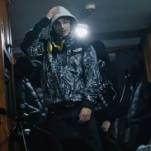The dead man is fictional, but the people in Putty Hill are mostly real, with the notable exception of Sky Ferreira, a pop singer who originally signed on for another Porterfield project, which fell through. Porterfield reportedly encouraged his cast to answer his questions as “themselves,” unless he asked about the deceased, at which point they could make up anything they wanted. It’s remarkable how much this simple gimmick adds to the film. Whether it’s the questions’ simplicity, the cast’s honesty, or the way Porterfield and editor Marc Vives carefully trim, nothing in Putty Hill comes off as some kind of forced, grand statement about life and death. The cast just tells little stories, which feel true even when they aren’t. The film is reminiscent of the best parts of River’s Edge, Paranoid Park, and Wassup Rockers, as Porterfield and cinematographer Jeremy Saulnier focus on the vibe of their locations: a creek where the kids gather to swim, a retirement home where the deceased’s grandmother watches Reba, a library where a little girl listens to a reading of Sylvester And The Magic Pebble, and so on.
The careful avoidance of sentiment holds Putty Hill back a little, because it’s hard to work up sympathy for the family and friends the junkie left behind. But t
hen the movie’s premise mainly provides Porterfield an excuse to study his cast, whether they be giggling teenage girls, a boyish metalhead who’s kind to his mom, or a pair of skate-rats buying snacks at a cramped convenience store. And even the disconnection between the characters and the reason for their gathering has the ring of truth. This is a movie about the casual ways people know each other, even when their relationships are hard to explain—or perhaps even justify.









































